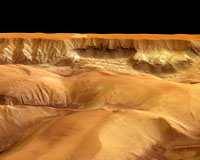 |
Leicester UK (SPX) Mar 15, 2010 Space physicists from the University of Leicester are part of an international team that has identified the impact of the Sun on Mars' atmosphere. Writing in the AGU journal Geophysics Research Letters, the scientists report that Mars is constantly losing part of its atmosphere to space. The new study shows that pressure from solar wind pulses is a significant contributor to Mars's atmospheric escape. The researchers analysed solar wind data and satellite observations that track the flux of heavy ions leaving Mars's atmosphere. The authors found that Mars's atmosphere does not drift away at a steady pace; instead, atmospheric escape occurs in bursts. The researchers related those bursts of atmospheric loss to solar events known as corotating interaction regions (CIRs). CIRs form when regions of fast solar wind encounter slower solar wind, creating a high-pressure pulse. When these CIR pulses pass by Mars, they can drive away particles from Mars's atmosphere. The authors found that during times when these CIRs occurred, the outflow of atmospheric particles from Mars was about 2.5 times the outflow when these events were not occurring. Furthermore, about one third of the material lost from Mars into space is lost during the impact and passing of CIRs. The study should help scientists better understand the evolution of Mars's atmosphere. Professor Mark Lester, Head of the Department of Physics and Astronomy at the University of Leicester said: "The main reason it happens at Mars and not at Earth is the lack of a magnetic field produced by the planet, which protects the atmosphere at Earth. "One other aspect of this work is that the observations were made during a very quiet period in the eleven year solar cycle and so we would expect the effect of these and other large scale disturbances to be higher at other times in the solar cycle." Leicester's role in the study was to analyse the data using ideas that academic researchers had from discussions within the Radio and Space Plasma Physics Research Group. Niklas Edberg, a doctoral student at the University of Leicester, who now works at the Swedish Institute for Space Physics (IRF), Uppsala, Sweden, conducted the research with Leicester colleagues Anthony Williams, Mark Lester, Steve Milan, and Stan Cowley of the Department of Physics and Astronomy. H. Nilsson, S. Barabash and Y. Futaana: Swedish Institute of Space Physics, Kiruna, Sweden and M. Fr�nz: Max Planck Institute for Solar System Research, Katlenburg-Lindau, Germany are co-authors of the paper.
Share This Article With Planet Earth
Related Links University of Leicester Mars News and Information at MarsDaily.com Lunar Dreams and more
 A Glow In The Martian Night
A Glow In The Martian NightMoffett Field CA (SPX) Mar 03, 2010 Astrobiology Magazine (AM): Let's talk about the paper you just published in the journal Science. Jean-Loup Bertaux (JLB): Our paper is about light that was discovered on the night side of Mars. Up to now, there has been no detection of this natural light, or "air glow." It has been seen on the day side of Mars by Mariner 6, 7 and 9 in the ultraviolet, but there were no observations of the ... read more |
|
| The content herein, unless otherwise known to be public domain, are Copyright 1995-2010 - SpaceDaily. AFP and UPI Wire Stories are copyright Agence France-Presse and United Press International. ESA Portal Reports are copyright European Space Agency. All NASA sourced material is public domain. Additional copyrights may apply in whole or part to other bona fide parties. Advertising does not imply endorsement,agreement or approval of any opinions, statements or information provided by SpaceDaily on any Web page published or hosted by SpaceDaily. Privacy Statement |